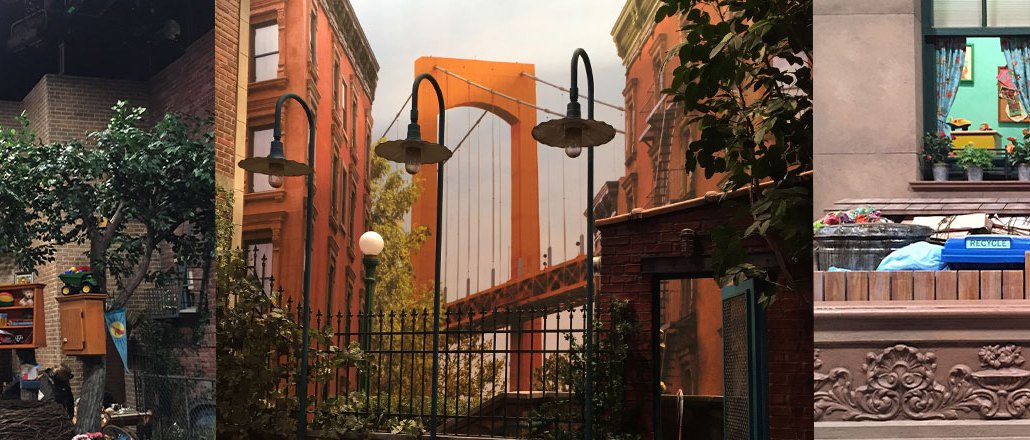Save 50% on a 3-month Digiday+ membership. Ends Dec 12.

“Sesame Street,” prepping for its 46th season this fall, is giving its iconic neighborhood a new look.
Digiday took a tour of the new set of the public television stalwart and found some big changes. Gone is Elmo’s building — he’s moved across the street to the brownstone at 123 — exposing a skyline that provides a new depth of field to the set. Abby Cadabby’s garden has been expanded to “Alice in Wonderland” proportions, complete with a compost bin where Oscar will make his visits. And Big Bird’s nest has, finally, been placed in a tree.
The new set — Mr. Hooper’s store still anchors the community — is part of a semi-regular “refresh” of the show, according to executive producer Carol-Lynn Parente.
“We evolve over time,” she told Digiday. “The refresh cycle has gotten shorter. It’s about five years ago that we did our last big change.”
There are few brands or media institutions that can boast the staying power and influence of “Sesame Street.” And it shows no signs of flagging: One of the most authoritative studies done on “Sesame Street” to date, released this month by Wellesley College economist Phillip Levine and University of Maryland economist Melissa Kearney, found that kids who watched “Sesame Street” as toddlers went on to do better in elementary school.
Kids who watched the show were more likely to stay at the appropriate grade level for their age, an effect that was particularly pronounced among boys, African-Americans and children who grew up in disadvantaged areas. The formula ain’t broke. But that’s not stopping the Sesame Workshop from tinkering with it.
Aside from the new set, expect more pivots in season 46 — including several changes they’re not discussing publicly yet. “Our point of differentiation in the marketplace is that there’s this real place with real characters,” said Parente, drawing a distinction from the bulk of children’s programming, which is primarily animated.
“Over the years, we’ve thought about fighting animation. But in trying to compete over time, our neighborhood had become one that did not reflect reality. It was not organic, almost garish.” So the new set — and the forthcoming season — reflects in a way a return to the show’s roots, even as the ‘hood appears to have gentrified a bit. The cast of Muppets, which has mushroomed over the decades, will be pared down to focus on a core six: Elmo, Cookie Monster, Abby Cadabby, Grover, Big Bird and Oscar. The others will still be on the show, but the core cast will be the daily focus.
As part of Sesame Street’s set redesign, Big Bird gets a new home: for the first time in 45 years his nest is nestled in a tree. A photo posted by Digiday (@digiday) on
The tighter cast will help focus the child viewers’ attention, too, but don’t expect the pace of action — which has ramped up considerably since 1969 — to slow down. “The media landscape has evolved,” said Parente. “You have to adapt to what the viewing expectations are of your audience.”
Today, that landscape includes social media. The most popular Muppets have Facebook pages and Twitter accounts, where parents are more likely to spend their time. Skits are created today with YouTube and Tumblr in mind, said Parente. “The magazine nature of the show gives us a variety of types of content to feed those platforms,” she said. “The key for successful content is to tailor it to the platform it’s on.”
And while educating kids remains central to the show’s purpose, the program — research-driven and not-for-profit from day one, free from commercial constraints — has a new mission statement: “Sesame Street” helps kids grow smarter, stronger and kinder. “From testing, we find parents think it really describes the brand and the show well,” said Parente. “It’s not just cognitively smarter, but it’s also emotionally smarter. It’s stronger physically, but it’s also more resilient.” Which, if anything, is a good way of describing the “Sesame Street” brand, too.
A photo posted by Digiday (@digiday) on
The new set backdrop adds depth to the shots and is inspired by buildings and bridges from across the city. A photo posted by Digiday (@digiday) on
More in Media

The Washington Post debuts AI-personalized podcasts to hook younger listeners
The Washington Post has used AI to build a pick-your-own-format news podcast, letting listeners choose the topics, hosts and duration.

Workforce data, smarter AI integration among greatest workplace priorities in the new year
The growing importance of workforce data is just one of the prognostications people managers are making looking to the year ahead.

WTF is AI citation tracking?
Publishers are tracking AI citations to understand visibility, attribution gaps and referral traffic in these tools and platforms.





